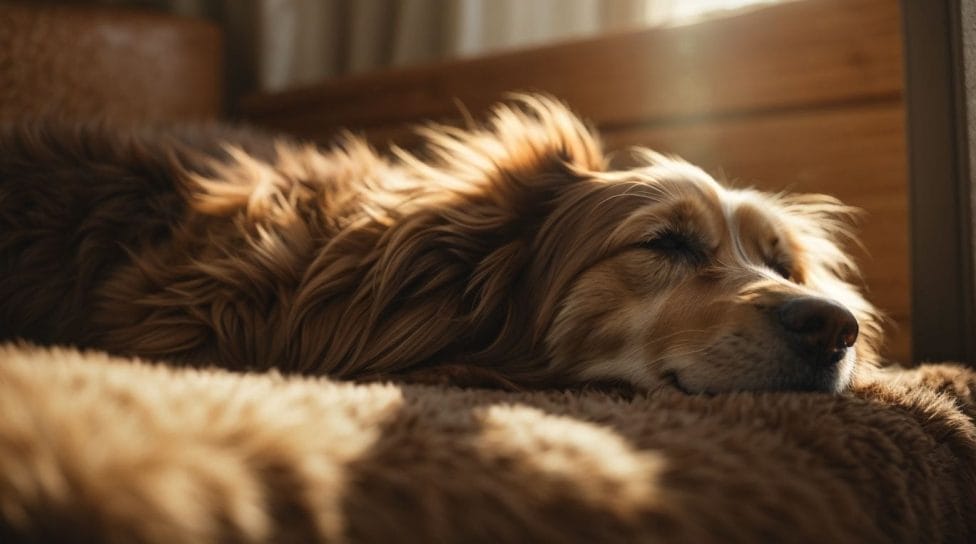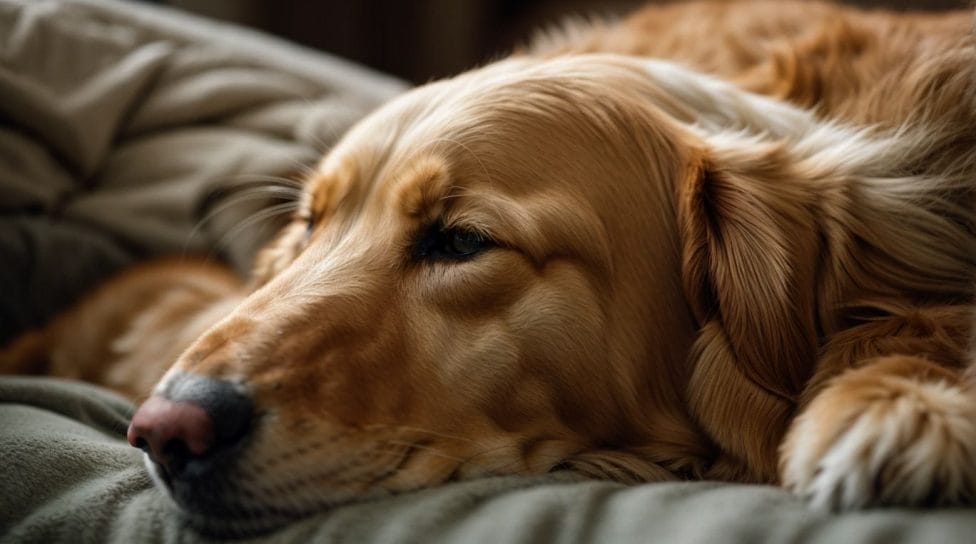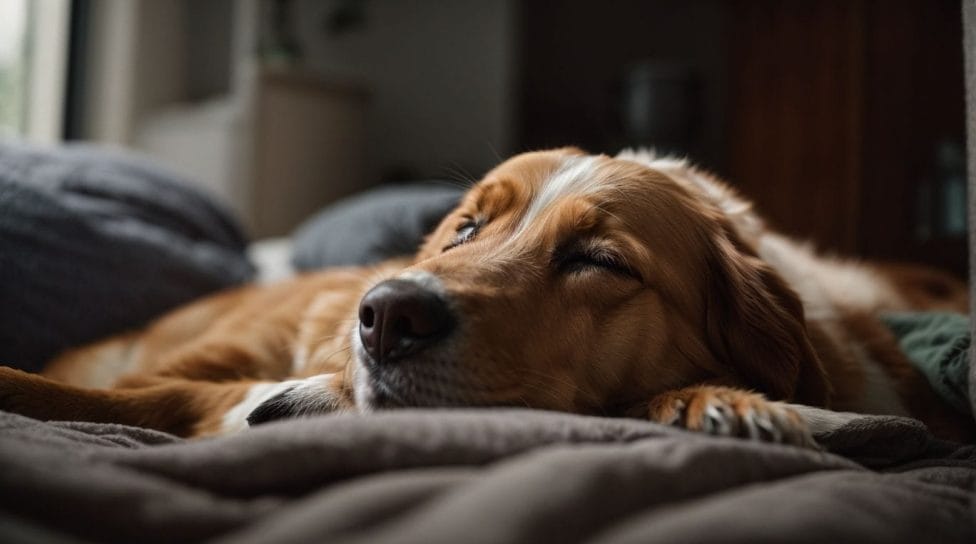Dogs have long been regarded as loyal companions to humans, and their behavior during sleep has sparked curiosity among pet owners. Whether dogs dream and they dream about their owners has intrigued many researchers and dog owners alike. This article will explore the fascinating world of dog dreams and illuminate this intriguing topic.
Firstly, do dogs dream? Studies have shown that dogs experience sleep cycles similar to humans, including rapid eye movement (REM) sleep, associated with dreaming. But what exactly do dogs dream about? While we can’t know for sure, evidence suggests that dogs may dream about familiar activities or experiences from their daily lives.
One question that dog owners often wonder about is whether dogs dream about their owners. While there are no definitive answers, some research suggests that dogs are likely to dream about people or animals that are significant in their lives, including their owners. Dogs may dream about playing, walking, or interacting with their beloved humans.
So, how do dogs show that they are dreaming? Paying attention to specific behaviors exhibited during sleep can provide clues. When dreaming, dogs may twitch, whimper, or bark and make rapid eye movements (REM sleep).
Research on dog dreaming has yielded interesting findings. Studies have shown that dogs exhibit similar brain patterns to humans during REM sleep, indicating that they may experience dreams. Observers have noticed specific behaviors in dogs during sleep, such as muscle cramps and paw movements, similar to what humans display during their dreams. Some studies have even explored the synchronization of dream patterns between dogs and their owners.
Several factors influence dogs’ dreams. Daily experiences and interactions play a role in shaping their dream content. Furthermore, the bond they share with their owners and the level of attachment can influence the focus of their dreams.
While dogs can have pleasant dreams, it is also possible for them to have nightmares. Traumatic experiences or unpleasant stimuli can cause these. Recognizing signs of distress during sleep, such as whimpering or thrashing, can help owners identify if their dogs are having nightmares.
As caring owners, there are ways to support our dogs’ dreaming experiences. Providing a comfortable sleeping environment, ensuring regular exercise, and maintaining a nurturing relationship with our furry friends can contribute to a positive dream state for our beloved canines.
While we may never fully understand the intricacies of our dogs’ dreams, delving into the research and observing their behaviors during sleep can offer insights into this captivating aspect of their lives.
Key takeaway:
- Dogs can dream: Research suggests that dogs dream during their sleep, similar to humans.
- Dogs may dream about their owners: While it is not yet confirmed, there is evidence that dogs may dream about their owners based on their behavior and brain patterns during sleep.
- Factors influencing dogs’ dreams: Daily experiences, interactions, and the bond with their owners may influence the content of dogs’ dreams.
Do Dogs Dream?

Photo Credits: Petnarnia.Com by Daniel Davis
Yes, dogs do dream. Studies have shown that dogs experience sleep patterns similar to humans, including REM (rapid eye movement) sleep, which is associated with dreaming. So, do dogs dream? During REM sleep, dogs may exhibit behaviors such as twitching, paddling their legs, or making sounds, indicating they are experiencing dreams. The content of their dreams is not fully understood, but it is believed to involve activities and experiences from their daily lives. So the next time you see your dog twitching in their sleep, ask yourself, “Do dogs dream?” They might just be chasing squirrels or playing fetch in their dreams.
What Do Dogs Dream About?

Photo Credits: Petnarnia.Com by Robert Taylor
What Do Dogs Dream About?
Dogs, just like humans, dream about a variety of things. While we cannot know what dogs dream about, studies suggest that they dream about activities they engage in during the day. Dogs may dream about playtime, chasing after toys, or interactions with their owners. In their dreams, dogs may also reenact their experiences, such as going for walks or exploring new places. Ultimately, what dogs dream about remains a mystery, but they likely dream about important things and reflect on their daily experiences.
Can Dogs Dream About Their Owners?
Yes, dogs can dream about their owners. Research has shown that dogs experience similar sleep patterns to humans, including the rapid eye movement (REM) stage associated with dreaming. Can Dogs Dream About Their Owners? During this stage, dogs may exhibit twitching movements, whimpering, and rapid eye movements, all suggesting they are dreaming. While we can’t know what dogs dream about, their dreams are likely influenced by their daily experiences and interactions, including their bond with their owners. So, dogs may dream about their owners based on the emotional attachment they have with them and the happy daytime experiences they share.
How Do Dogs Show That They Are Dreaming?

Photo Credits: Petnarnia.Com by Jesse Hernandez
Have they ever wondered how dogs show that they are dreaming? Let’s dive into the fascinating world of canine slumber. Dogs have unique ways of indicating their dreams, from twitching movements to whimpering or barking and those mysterious rapid eye movements. So, buckle up as we explore the intriguing sleep behaviors of our beloved furry friends.
1. Twitching Movements
- Twitching movements in dogs during sleep can indicate that they are dreaming. Here are some steps to understand and interpret these movements:
- Observe the twitching: Notice if your dog’s legs or other body parts move rapidly during sleep.
- Identify the stage of sleep: Twitching movements typically happen during the REM stage of sleep.
- Understand the dream content: While it’s impossible to know exactly what dogs dream about, their twitching movements suggest they may be experiencing vivid dreams.
- Consider daily experiences: Dogs’ dreams can be influenced by their daytime experiences, interactions, and emotions.
- Provide a comfortable environment: Ensure your dog has a cozy sleeping space to enhance their sleep and dreaming experience.
2. Whimpering or Barking
Whimpering or barking in dogs during sleep can indicate that they are dreaming. Here are some steps to understand and support dogs during this process:
- Observe: Pay attention to your dog while they’re asleep and listen for any whimpering or barking sounds.
- Comfort: If your dog appears to have a bad dream, gently wake them up to offer reassurance and comfort.
- Create a calm environment: Ensure your dog’s sleeping space is comfortable, quiet, and disturbances-free.
- Daily activities: Engage your dog in stimulating activities during the day to promote better sleep and reduce the likelihood of unsettling dreams.
Following these steps can help your dog have a more relaxed and peaceful sleep, improving overall well-being.
3. Rapid Eye Movements
Rapid Eye Movements (REM) occur naturally during a dog’s sleep and serve as a clear indication of dreaming. These REM movements are specifically observed during the REM stage of sleep, mirroring the dreaming experience of humans. Numerous studies have established that dogs exhibit various activities during their dreams, including twitching movements, whimpering or barking, and rapid eye movements. REM sleep cycles in dogs strongly suggest that they also have vivid dreams, potentially encompassing memories and moments from their daily lives. Esteemed sleep behavior experts from Harvard Medical School, MIT, and Stanford University have conducted research that further supports the notion that dogs do indeed dream, even about their beloved owners. To encourage dogs’ dreaming, it is essential to ensure they have joyful daytime experiences and a cozy sleep environment.
What Research Says About Dogs Dreaming?

Photo Credits: Petnarnia.Com by Arthur Clark
Have you ever wondered if dogs dream about their owners? Let’s dive into what research says about dogs and their dreams. We’ll explore fascinating topics like their brain patterns, observations of behaviors during sleep, and even studies on dream synchronization with their beloved owners. Get ready to unveil the secrets behind our furry friends’ dream world!
1. Similar Brain Patterns to Humans
In recent studies, it has been discovered that dogs exhibit brain patterns that are similar to those of humans when they are dreaming. Researchers from Harvard Medical School, MIT, and Stanford University have found that dogs’ brain activity during REM sleep cycles, where dreaming occurs, closely resembles that observed in humans. This suggests that dogs, much like humans, may have vivid dreams during this stage of sleep. These findings further support the understanding that dogs possess complex cognitive abilities and emotional experiences like humans.
Providing a comfortable sleeping environment is important to ensure your dog gets a good sleep quality and can dream. Daily activities and positive interactions with your dog can also contribute to positive dream content. If you notice any unusual or concerning behaviors during your dog’s sleep or waking time, it is advised to seek professional guidance from a veterinary behaviorist.
Acknowledging and respecting our dogs’ dreaming experiences can improve their well-being and strengthen our bond.
2. Observations of Dog Behaviors During Sleep
During sleep, dogs exhibit various behaviors that suggest they are dreaming. These observations of dog behaviors during sleep, including twitching movements, whimpering or barking, and rapid eye movements, provide insights into their dreams and experiences. Research suggests that dogs experience similar sleep patterns to humans, including REM (rapid eye movement) sleep cycles associated with dreaming. By understanding these observations of dog behaviors during sleep, owners can support their dogs’ dreaming by providing happy daytime experiences and ensuring a comfortable sleep environment. Veterinary behaviorists and sleep researchers from institutions such as the University of California Davis School of Veterinary Medicine and Harvard Medical School have studied these observations to gain further understanding of dogs’ dream patterns.
3. Studies on Dream Synchronization with Owners
The studies on dream synchronization between dogs and their owners have revealed fascinating findings. Researchers from prestigious institutions such as the University of California Davis School of Veterinary Medicine, Harvard Medical School, and Stanford University have conducted these studies. Their research has discovered that dogs have the remarkable ability to synchronize their dreams with their owners. This synchronization is influenced by various factors, including the emotional bond between the dog and the owner, shared daily experiences, and the quality of their attachment. These studies not only shed light on the deep connection between dogs and their owners but also emphasize that even in their dreams, they are connected profoundly.
What Factors Influence Dogs’ Dreams?

Photo Credits: Petnarnia.Com by Roy Brown
Have you ever wondered what factors influence dogs’ dreams? Let’s delve into the fascinating world of canine dreams and explore how daily experiences and interactions, as well as the bond with their owners and attachment, play a role in shaping the dreams of our beloved furry friends. Say goodbye to the mystery and get ready to uncover the elements that makeup dogs’ captivating and enigmatic dreams.
1. Daily Experiences and Interactions
Daily experiences and interactions play a significant role in shaping dogs’ dreams. Dogs often dream about events and interactions they have encountered throughout the day. These daily experiences and interactions can range from playing at the park and going for walks to meeting new people and other animals. Positive and enjoyable daily experiences and interactions can result in happy and pleasant dreams for dogs. On the other hand, negative or stressful daily experiences and interactions may influence dogs to have dreams that reflect those emotions. Therefore, owners must provide their dogs with a supportive and enriching environment to cultivate positive daily experiences and interactions.
2. Bond with Owners and Attachment
Bonding with their owners and developing a strong attachment is crucial for dogs and can profoundly impact their dreams.
- Emotional Connection: Dogs with a deep connection with their owners may dream about them. This profound bond can significantly influence the content of their dreams.
- Positive experiences: Dogs who enjoy joyful interactions and experiences with their owners throughout the day are likelier to have pleasant dreams while asleep.
- Feeling Secure: A robust bond with their owners can instill a sense of safety and security in dogs while they sleep, enabling them to experience more restful and peaceful dreams.
- Behavioral Effects: Dogs that share a strong attachment to their owners may exhibit physical signs of their attachment in their dreams, such as wagging their tails or twitching their legs as if they are running.
Can Dogs Have Nightmares?

Photo Credits: Petnarnia.Com by Bradley Moore
Can Dogs Have Nightmares?
Yes, dogs can indeed experience nightmares just like humans. Can dogs have nightmares? Nightmares in dogs are often characterized by whining, growling, or even kicking their legs while asleep. It is believed that dogs may experience nightmares due to stressful or traumatic experiences during their waking hours. Factors such as anxiety, fear, or changes in their environment can trigger these nightmares. Providing a calm and secure sleeping environment, regular exercise, and positive reinforcement training can help reduce the likelihood of nightmares in dogs. If you notice your dog having frequent nightmares, it is advisable to consult with a veterinarian to determine any underlying health issues or potential triggers.
How Can Owners Support Dogs’ Dreaming?

Photo Credits: Petnarnia.Com by Gabriel Robinson
Supporting your dog’s dreaming can contribute to their overall well-being and quality of sleep. Here are some ways owners can support dogs’ dreaming experiences and promote their overall health:
- Comfortable sleep environment: How can owners support dogs’ dreaming? Provide a cozy, quiet space for your dog to relax and feel secure.
- Consistent sleep schedule: How can owners support dogs’ dreaming? Maintaining a regular sleep routine helps regulate your dog’s internal clock and promotes uninterrupted sleep.
- Physical and mental stimulation: How can owners support dogs’ dreaming? Engage your dog in regular exercise and mental enrichment activities to tire them out, which can lead to more restful sleep and vivid dreams.
- Limit disturbances: How can owners support dogs’ dreaming? Minimize external disturbances, such as loud noises or bright lights, that may interrupt or disrupt your dog’s sleep and dream patterns.
- Support relaxation: How can owners support dogs’ dreaming? Use calming techniques like massage, aromatherapy, or soothing music to help your dog relax and sleep deeper.
By implementing these practices, owners can create an optimal sleep environment for their dogs, helping to support their dreaming experiences and overall health.
Some Facts About “Do Dogs Dream About Their Owners?”:
- ✅ Dogs can dream; signs of dreaming include twitching, rapid eye movement, and vocalization. (Source: Forbes)
- ✅ Dogs and humans have similar sleep patterns, with deep sleep stages and Rapid Eye Movement (REM) sleep. (Source: Pawfect Stays)
- ✅ Dogs dream visually about things that interest them and that they are emotionally attached to. (Source: Pawfect Stays)
- ✅ Dogs are likely to dream about their human owners, as they are the most important thing in their lives. (Source: Pawfect Stays)
- ✅ Dogs have a mechanism in their brains that relaxes their muscles during sleep, but this can falter, allowing them to act out their dreams. (Source: Pawfect Stays)


